Click on images to enlarge
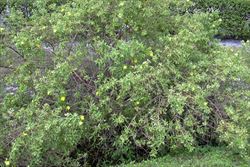
spreading habit (Photo: Forest and Kim Starr, USGS)
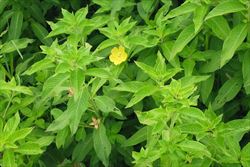
habit (Photo: Mellisa Offord)
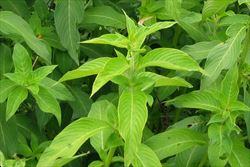
leaves (Photo: Mellisa Offord)
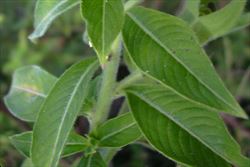
close-up of hairy stem and leaves (Photo: Forest and Kim Starr, USGS)

close-up of flower and hairy, four-angled, young fruit (Photo: Forest and Kim Starr, USGS)
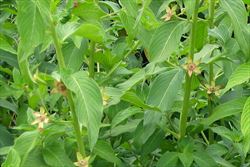
immature fruit in the leaf forks (Photo: Mellisa Offord)
Scientific Name
Ludwigia peruviana (L.) Hara
Synonyms
Jussiaea peruviana L.
Family
Onagraceae
Common Names
ludwigia, Peruvian primrose, Peruvian primrose bush, Peruvian primrose-willow, Peruvian primrosebush, primrose willow, water primrose
Origin
Native to Mexico, Central America (i.e. Belize, Costa Rica, El Salvador, Guatemala, Honduras, Nicaragua and Panama), the Caribbean and South America (i.e. Venezuela, Brazil, Bolivia, Colombia, Ecuador, Peru, Argentina, Chile, Paraguay and Uruguay).
Cultivation
This species has been cultivated as an garden ornamental in the past.
Naturalised Distribution
Locally naturalised in the coastal districts of central New South Wales.
Also naturalised overseas in south-eastern India, Sri Lanka, Indonesia, south-eastern USA (i.e. Texas, Louisiana, Alabama, Florida, Georgia and North Carolina) and French Polynesia.
Habitat
A potential weed of warmer temperate, sub-tropical and tropical regions that is usually found in wetlands, swamps, marshes and along the edges of lagoons and slow-moving waterways (sometimes also floating on the water surface).
Habit
A large, long-lived (i.e. perennial), wetland shrub usually growing 2-3 m tall, but occasionally reaching up to 4 m in height. It loses its leaves during winter (i.e. it is deciduous) in cooler climates and sometimes also floats freely on the water surface.
Distinguishing Features
- a large long-lived wetland shrub much-branched stems usually growing 2-4 m tall.
- its younger stems and leaves are hairy.
- its alternately arranged leaves (5-12 cm long and 1-3 cm wide) are have prominent veins.
- its flowers (2-4 cm across) are borne singly and have four or five bright yellow petals and four or five persistent sepals.
- its reddish or brownish fruit (10-25 mm long and 6-10 mm wide) are four-angled and hairy.
Stems and Leaves
The stems are green or brownish-green in colour and are much-branched. Younger stems are usually rounded and hairy (i.e. pubescent).
The leaves are alternately arranged, or rarely paired, and are stalkless (i.e. sessile) or borne on very short stalks (i.e. petioles). These leaves (5-12 cm long and 1-3 cm wide) have prominent veins and are covered in hairs (i.e. pubescent). They are generally egg-shaped in outline (i.e. ovate), oval (i.e. elliptic) or elongated in shape (i.e. lanceolate) with entire margins. Their have upper surfaces are usually darker green than their paler undersides.
Flowers and Fruit
The yellow flowers (2-4 cm across) are borne singly on stalks originating in the forks (i.e. axils) of the upper leaves. These flowers usually have four petals (1-3 cm long and 1-3 cm wide), but occasionally there are five or six petals present. They also have four large green sepals that are persistent and turn reddish in colour as the fruit begins to mature. Flowering occurs mostly during late summer and autumn.
The reddish or brownish coloured fruit is an upright, four-angled, and slightly elongated capsule (10-25 mm long and 6-10 mm wide) containing large numbers of seeds (i.e. 1000-3000). These tiny seeds (0.6-0.8 mm long) are light brown in colour and almost rounded in shape (i.e. sub-globular).
Reproduction and Dispersal
This species reproduces by seed and also vegetatively via suckers from submerged stems or stem fragments.
Seeds are dispersed mostly by water and birds, but also by wind, machinery and in mud. Stem fragments may be spread by floods, machinery or during removal.
Environmental Impact
Peruvian primrose (Ludwigia peruviana) is regarded as an environmental weed in New South Wales and as a potential environmental weed or "sleeper weed" in many other parts of Australia. During a recent survey, it was listed as a priority environmental weed in at least one Natural Resource Management region. While currently relatively localised in central New South Wales, Peruvian primrose (Ludwigia peruviana) is thought to have the potential to become a major aquatic weed in eastern Australia
Peruvian primrose (Ludwigia peruviana) is mainly naturalised around swampy lake margins in and around Sydney. This species has become dominant in the Botany Wetlands, replacing much of the former vegetation of this series of shallow urban swamps and lakes. It is also considered to be a threat to endangered freshwater wetlands throughout the Sydney Basin bioregion. In recent years the distribution of this species has begun to expand. It has been found in Hornsby Shire, in northern Sydney, and a few outbreaks have also been recorded along drainage channels, creeks, and near lagoons in the Gosford and Port Stephens areas in the New South Wales Central Coast region.
This species forms dense, monotypic stands in shallow slowly-flowing waterways, as well as in marshy areas, riparian vegetation and around the margins of still waterbodies. Once established, it sprawls out into the water surface and can form floating islands of vegetation. Its tall dense growth excludes most other vegetation and reduces light levels reaching the water surface, eventually replacing native vegetation and reducing biodiversity in invaded areas. It also causes more wide-ranging ecological damage, through increased sedimentation and accumulation of organic material. This results in the deoxygenation of the water column and can lead to the death of aquatic animals.
Other Impacts
The dense growth of Peruvian primrose (Ludwigia peruviana ) can clog waterways, limiting their usefulness for recreational activities, impeding the movement of watercraft, reducing the access of native animals and/or livestock for drinking water, and blocking water pumps. This dense growth can also decrease the rate of flow in streams, increasing the frequency and severity of flooding events.
Legislation
This species is declared under legislation in the following states and territories:
- Queensland: Class 1 - introduction into the state is prohibited, and landowners must take reasonable steps to keep land free of this species (throughout the entire state). It is also illegal to sell a declared plant or its seed in this state.
- New South Wales: Class 3 - a regionally controlled weed. The relevant local control authority must be promptly notified of the presence of this weed and it must be fully and continuously suppressed and destroyed (in a large number of local authority areas). See the New South Wales Department of Primary Industries Noxious Weeds List at http://www.dpi.nsw.gov.au for more detailed information on which local areas are covered in these declarations.
- South Australia: 1@ - this species is declared in Class 1a, a category for prohibited terrestrial plants. Its presence must be notified and the plant must be destroyed (throughout the entire state).
- Western Australia: Prohibited - on the prohibited species list and not permitted entry into the state.
Management
For information on the management of this species see the following resources:
- the New South Wales Department of Primary Industries Weed Alert on this species, which is available online at http://www.dpi.nsw.gov.au.
- the Strathfield Council weed fact sheet on this species, which is available online at http://www.strathfield.nsw.gov.au.
- the Campbelltown City Council Noxious Weeds Profile Sheet on this species, which is available online at http://www.campbelltown.nsw.gov.au.
- the Sutherland Shire Council weed fact on this species, which is available online at http://www.sutherland.nsw.gov.au.
- the Ludwigia or water primrose page on the South Coast Weeds website at http://www.esc.nsw.gov.au/Weeds/index.asp.
Similar Species
Peruvian water primrose (Ludwigia peruviana) is similar to several closely related species including native willow primrose (Ludwigia octovalvis), long-leaved willow primrose (Ludwigia longifolia) and water primrose (Ludwigia peploides subsp. montevidensis). These species can be distinguished by the following differences:
- Peruvian water primrose (Ludwigia peruviana) is an upright (i.e. erect) shrub with rounded stems and leaves that are covered in hairs (i.e. pubescent). Its relatively broad leaves are generally egg-shaped in outline (i.e. ovate). Its flowers usually have four large yellow petals and its fruit (10-25 mm long) are hairy (i.e. pobescent) and four-angled in cross-section.
- long-leaved willow primrose (Ludwigia longifolia) is an upright (i.e. erect) woody herb or small shrub with four-angled stems and leaves that are hairless (i.e. glabrous). Its glossy leaves are elongated (i.e. lanceolate) or linear in shape. Its flowers usually have four large yellow petals and its fruit (10-35 mm long) are hairless (i.e. glabrous) and four-angled in cross-section.
- native willow primrose (Ludwigia octovalvis) is an upright (i.e. erect) woody herb or small shrub with rounded stems and leaves that are usually covered in hairs (i.e. pubescent). Its leaves are quite variable and can be egg-shaped in outline (i.e. ovate) to very elongated in shape (i.e. linear-lanceolate). Its flowers usually have four large yellow petals and its fruit (20-45 mm long) are hairy (i.e. pubescent) and rounded in cross-section.
- water primrose (Ludwigia peploides subsp. montevidensis) is a creeping (i.e. prostrate or decumbent) or floating plant with rounded stems and leaves that are mostly hairless (i.e. glabrous). Its glossy leaves can be egg-shaped in outline (i.e. ovate) to elongated (i.e. lanceolate) in shape. Its flowers usually have five yellow petals and its fruit (10-30 mm long) are mostly hairless (i.e. glabrous) and rounded in cross-section.

